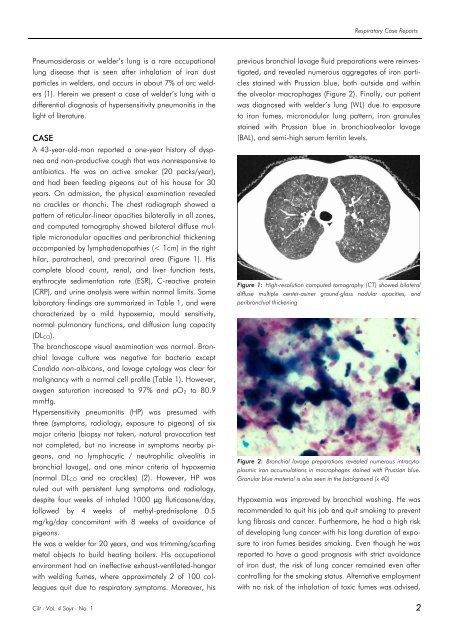Respircase Cilt: 4 - Sayı: 1 Yıl: 2015
Create successful ePaper yourself
Turn your PDF publications into a flip-book with our unique Google optimized e-Paper software.
Respiratory Case Reports<br />
Pneumosiderosis or welder’s lung is a rare occupational<br />
lung disease that is seen after inhalation of iron dust<br />
particles in welders, and occurs in about 7% of arc welders<br />
(1). Herein we present a case of welder’s lung with a<br />
differential diagnosis of hypersensitivity pneumonitis in the<br />
light of literature.<br />
CASE<br />
A 43-year-old-man reported a one-year history of dyspnea<br />
and non-productive cough that was nonresponsive to<br />
antibiotics. He was an active smoker (20 packs/year),<br />
and had been feeding pigeons out of his house for 30<br />
years. On admission, the physical examination revealed<br />
no crackles or rhonchi. The chest radiograph showed a<br />
pattern of reticular-linear opacities bilaterally in all zones,<br />
and computed tomography showed bilateral diffuse multiple<br />
micronodular opacities and peribronchial thickening<br />
accompanied by lymphadenopathies (< 1cm) in the right<br />
hilar, paratracheal, and precarinal area (Figure 1). His<br />
complete blood count, renal, and liver function tests,<br />
erythrocyte sedimentation rate (ESR), C-reactive protein<br />
(CRP), and urine analysis were within normal limits. Some<br />
laboratory findings are summarized in Table 1, and were<br />
characterized by a mild hypoxemia, mould sensitivity,<br />
normal pulmonary functions, and diffusion lung capacity<br />
(DL CO).<br />
The bronchoscope visual examination was normal. Bronchial<br />
lavage culture was negative for bacteria except<br />
Candida non-albicans, and lavage cytology was clear for<br />
malignancy with a normal cell profile (Table 1). However,<br />
oxygen saturation increased to 97% and pO 2 to 80.9<br />
mmHg.<br />
Hypersensitivity pneumonitis (HP) was presumed with<br />
three (symptoms, radiology, exposure to pigeons) of six<br />
major criteria (biopsy not taken, natural provocation test<br />
not completed, but no increase in symptoms nearby pigeons,<br />
and no lymphocytic / neutrophilic alveolitis in<br />
bronchial lavage), and one minor criteria of hypoxemia<br />
(normal DL CO and no crackles) (2). However, HP was<br />
ruled out with persistent lung symptoms and radiology,<br />
despite four weeks of inhaled 1000 μg fluticasone/day,<br />
followed by 4 weeks of methyl-prednisolone 0.5<br />
mg/kg/day concomitant with 8 weeks of avoidance of<br />
pigeons.<br />
He was a welder for 20 years, and was trimming/scarfing<br />
metal objects to build heating boilers. His occupational<br />
environment had an ineffective exhaust-ventilated-hangar<br />
with welding fumes, where approximately 2 of 100 colleagues<br />
quit due to respiratory symptoms. Moreover, his<br />
previous bronchial lavage fluid preparations were reinvestigated,<br />
and revealed numerous aggregates of iron particles<br />
stained with Prussian blue, both outside and within<br />
the alveolar macrophages (Figure 2). Finally, our patient<br />
was diagnosed with welder’s lung (WL) due to exposure<br />
to iron fumes, micronodular lung pattern, iron granules<br />
stained with Prussian blue in bronchioalveolar lavage<br />
(BAL), and semi-high serum ferritin levels.<br />
Figure 1: High-resolution computed tomography (CT) showed bilateral<br />
diffuse multiple center-asiner ground-glass nodular opacities, and<br />
peribronchial thickening<br />
Figure 2: Bronchial lavage preparations revealed numerous intracytoplasmic<br />
iron accumulations in macrophages stained with Prussian blue.<br />
Granular blue material is also seen in the background (x 40)<br />
Hypoxemia was improved by bronchial washing. He was<br />
recommended to quit his job and quit smoking to prevent<br />
lung fibrosis and cancer. Furthermore, he had a high risk<br />
of developing lung cancer with his long duration of exposure<br />
to iron fumes besides smoking. Even though he was<br />
reported to have a good prognosis with strict avoidance<br />
of iron dust, the risk of lung cancer remained even after<br />
controlling for the smoking status. Alternative employment<br />
with no risk of the inhalation of toxic fumes was advised,<br />
<strong>Cilt</strong> - Vol. 4 <strong>Sayı</strong> - No. 1 2

















